Principles of Financial Accounting Finals (Part 2)
1/42
There's no tags or description
Looks like no tags are added yet.
Name | Mastery | Learn | Test | Matching | Spaced |
|---|
No study sessions yet.
43 Terms
Inventory concepts
Inventory is property held for sale in the normal course of business
Manufacturing firms have:
Raw materials inventory
Work in process inventory
Finished goods inventory
Different industries have different types of inventory
Gross profit and cost of goods sold
Expenditures for products manufactured or expenditures for goods purchased for sale
Expenditure → inventory (current asset)
When the products are sold
Cost of inventory sold → cost of goods sold (expense)
Gross profit = net sales - cost of goods sold
Net income = gross profit - expenses
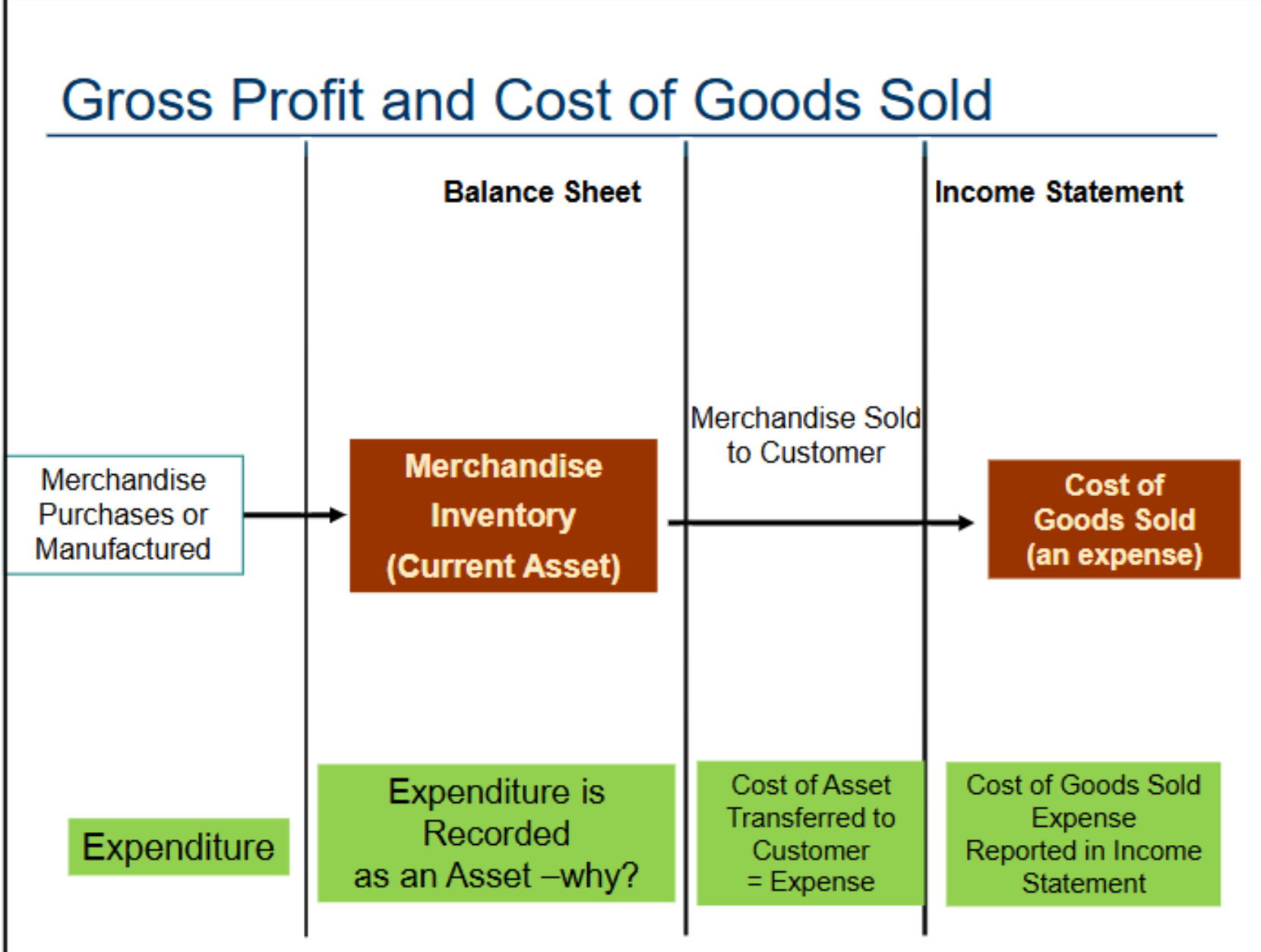
Perpetual inventory basis vs periodic inventory basis
Perpetual inventory basis
Cost of goods sold recorded for each sale
Purchases of inventories are recorded directly in an inventory account
Inventory balance is reduced by cost of each sale
Information on cost of goods sold and ending inventory updated continuously, perpetually
Periodic inventory basis
Cost of goods sold is calculated at the end of period using cost of goods sold equation after a physical count of unsold inventory
Inventory purchases are initially debited to an account called purchases
No up-to-date record of inventory is maintained during the period
Information on cost of goods sold and ending inventory updated only at the end of the period
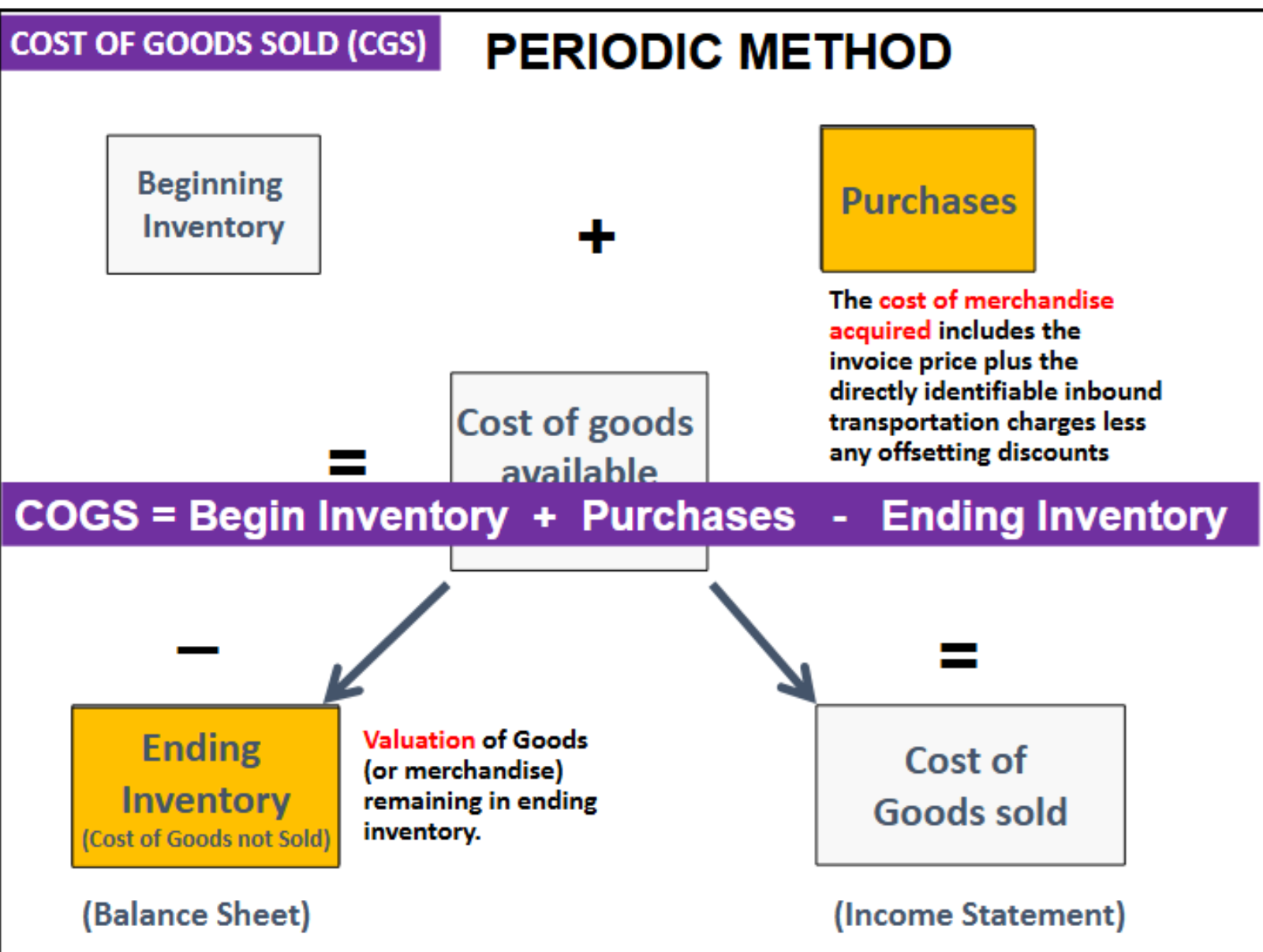
Periodic method
GOGS = cost of beginning inventory + cost of merchandise acquired/purchases - cost of ending inventory
Cost of goods available = beginning inventory + purchases
*Cost of beginning inventory:
How much inventory you had in the beginning of a period
*Cost of merchandise acquired/Purchases: The cost of merchandise acquired includes the invoice price plus the directly identifiable inbound transportation charges less any offsetting discounts
How much inventory you bought
*Ending inventory (balance sheet): Cost of goods not sold. Valuation of goods (or merchandise) remaining in ending inventory
How much inventory you have left, leftover from beginning inventory
*Cost of good sold (income statement)
Cost principle
The cost of any asset is the sum of all the costs incurred to bring the asset to its intended use
Purchase price
Shipping cost (freight-in)
Insurance in transit
If manufacture yourself, include material, labor and overheard
Footnote disclosure
Cost of goods sold:
Total cost of products sold including freight expenses associated with moving merchandise inventories from our vendors to our distribution centers
Cost of services provided
Physical inventory losses
Markdowns (LCM - later)
Costs associated with operating our distribution network, including payroll and benefit costs, occupancy costs, and depreciation
Freight expenses associated with moving merchandise inventories from our distribution centers to our retail stores
Valuation of ending inventory
Ending inventory = beginning inventory + purchases - units sold
Beginning inventory of 2,000
Purchased 4,000 and then purchased 1,000 on a different day
Sold 4,000
2,000+4,000+1,000-4,000
There are different methods to compute COGS and the value of ending inventory allowed by GAAP:
1) First-in, first-out (FIFO) cost
2) Last-in, first-out (LIFO) cost
3) Weighted-average cost
FIFO
FIFO assigns the cost of the earliest acquired units to cost of goods sold
The cost of the newer units is assigned to the units in ending inventory
FIFO provides inventory valuations that closely approximate the actual market value of the inventory balance sheet date
Sells the old/cheaper inventory → low COGS → high profit → higher taxes
Oldest costs (earliest purchases) → cost of goods sold
Recent costs (latest purchases) → ending inventory
LIFO
LIFO assigns the most recent cost to cost of goods sold
LIFO provides an income statement perspective in that net income measured using LIFO combines current sales prices and current acquisition costs
THE IRS requires companies that use LIFO for tax purposes to also use it for financial reporting purposes
Sell sells the expensive new/latest inventory → high COGS → low profit → lower taxes
Recent costs (latest purchases) → cost of goods sold
Oldest costs (earliest purchases) → ending inventory
Weighted average method
Disregards beginning/ending inventory
Weighted average method = Cost of available for sale / Units
Comparing FIFO and LIFO methods
Summary of income effects: when inventory unit costs are increasing
FIFO:
Highest ending inventory
Lowest COGS
Highest gross profit
Highest pretax income
Highest income tax
LIFO:
Lowest ending inventory
Highest COGS
Lowest gross profit
Lowest pretax income
Lowest income tax
Summary of income effects: when inventory unit costs are decreasing
FIFO:
Lowest ending inventory
Highest COGS
Lowest gross profit
Lowest pretax income
Lowest income tax
LIFO:
Highest ending inventory
Lowest COGS
Highest gross profit
Highest pretax income
Highest income tax
Adjusting from LIFO to FIFO inventory amounts
Facilitate comparisons across firms with different inventory valuation methods
Use a disclosure called LIFO Reserve to restate LIFO inventories and income statement to FIFO
US GAAP: LIFO firms have to disclose LIFO reserve in their financial reports
LIFO Reserve = FIFO inventory amount - reported LIFO inventory amount
Difference between FIFO and LIFO inventories amounts
FIFO inventory amount = reported LIFO inventory + LIFO Reserve
Adjusting from LIFO based income statement to FIFO income statement
LIFO reserve = FIFO inventory valuation - LIFO inventory valuation
Beginning LIFO reserve = FIFO beginning inventory - LIFO beginning inventory
FIFO beginning inventory = LIFO beginning inventory + beginning LIFO reserve
Ending LIFO reserve = FIFO ending inventory - LIFO ending inventory
FIFO ending inventory = LIFO ending inventory + ending LIFO reserve
FIFO COGS = FIFO beginning inventory + purchases - FIFO ending inventory
FIFO COGS = LIFO COGS - change in LIFO reserve (fix pretax income under FIFO)
FIFO beginning inventory = LIFO beginning inventory + beginning LIFO reserve
FIFO ending inventory = LIFO ending inventory + ending LIFO reserve
Change in LIFO reserve = ending LIFO reserve - beginning LIFO reserve
Converting LIFO gross profit to FIFO gross profit
FIFO gross profit = LIFO gross profit + change in LIFO reserve
Valuation at lower of cost or market
Ending inventory is reported at the lower of cost or market (LCM)
Market cost
Replacement cost of inventory
The current purchase price for identical goods
Net sales price of damaged or obsolete inventory
Holding loss:
Difference between purchase cost and the lower market cost
added to the cost of goods for the period
Gross profit percentage/gross margin percentage
Gross profit percentage = gross profit/net sales revenue
*A 36% gross profit means that each dollar of sales generates 36 cents of gross profit and the goods cost the seller 64 cents
Rule of thumb: compare the company’s gross profit percentage with the industry average or that of another competitor. Also compare to historical gross profit percentages. A small downturn may signal an important drop in net income.
Inventory turnover
Measures how many times a company has sold and replaced inventory during a given period. Indicates how efficient a firm is managing its inventory. Higher inventory turnover is better.
Inventory turnover = sales revenue / average inventory OR COGS / average inventory
Note can use COGS instead of sales. More accurate because sales includes a markup over inventory cost.
Normally industries that have high profit margins have lower turnover and industries with low profit margins have higher turnover
Day to sell inventory = 365 / inventory turnover
Valuation of long-lived tangible and intangible assets
Fixed/tangible assets:
Acquiring fixed assets
Depreciation
Disposal of fixed assets
Intangible assets:
Capitalization
Amortization
Impairment assessment
Fixed assets
Long-lived assets used in operations known as plant assets, fixed assets or PPE:
Land
Buildings
Equipment/machinery
Reported net of accumulated depreciation on balance sheet
Cost of asset expensed in income statement through depreciation
Land is typically not depreciated (exception of land used for garbage)
Assets vs. expenses
Conditions for an expenditure to be classified as an asset
a. probable long term benefit
b. reliable measurability of expected benefits
c. part of construction
Balance sheet
Otherwise classify as expense
income statement
Calculating long-lived assets example
Property and liability insurance on the land and building for the first year was $12,000, of which $4,000 applied to the period during renovation and $8,000 applied to the period after opening. The relative market values of the land and building are 20% for the land and 80% for the building.
20% X $4,000 = $800 = land
80% X $4,000 = $3,200 = building
During renovation: expenses during construction/renovation are considered as assets because they support future benefits
After opening: expenses after construction/renovation become regular operating expenses
Post-purchase costs: capitalization vs. expensing
When a company spends money on an asset, it must determine whether the cost was an improvement to the asset or simply a repair expense
Capital expenditures: increases the asset’s capacity or efficiency or extend its useful life. Record as an asset (capitalize) and depreciate.
Ex: replacing an old engine in a car
Assets in balance sheet
Ordinary repairs: do not extend the asset’s capacity or useful life, but merely maintain it or restore it to working order. Expense immediately.
Ex: pumping oil in car
Expenses in income statement
Allocation of cost of long-lived asset - depreciation and amortization
Cost of long-lived asset similar to prepaid expense
Depreciation expense: cost of asset allocated to periods used
Accumulated depreciation: portion of cost of asset written off as depreciation expense
Amortization expense: refers to depreciation of intangible assets
Book value of long-lived asset/net asset = cost of asset - accumulated depreciation
Measuring depreciation and amortization
To measure depreciation, we must know:
1) Cost
2) Estimated residual value (scrap or salvage value)
The expected value of an asset at the end of its useful life
Estimated residual value is not depreciated because the business expects o receive this amount from disposing of the asset
Depreciable cost = cost - residual value
3) Estimated useful life or economic life
The length of service the business expects to get from the asset - an estimate of how long an asset will be useful
Useful life may be expressed in years, units of output, miles, or another measure
Three common methods for computing depreciation
Straight line
Units depreciation - usage
Accelerated depreciation
Double declining-balance
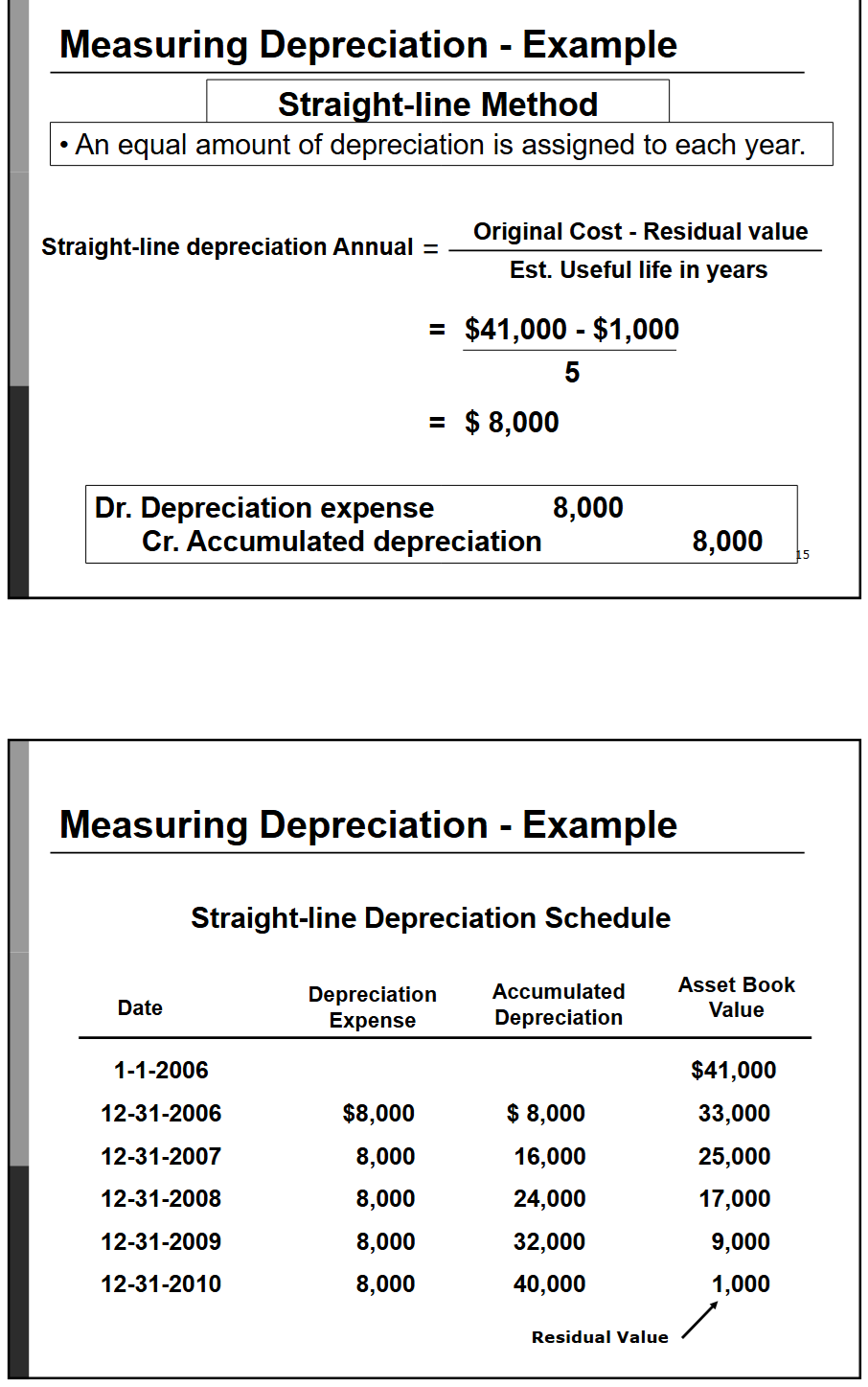
Measuring depreciation - straight line
An equal amount of depreciation is assigned to each year
Cost - residual value = depreciable cost
Straight-line depreciation per year = cost - residual value / economic life (years)
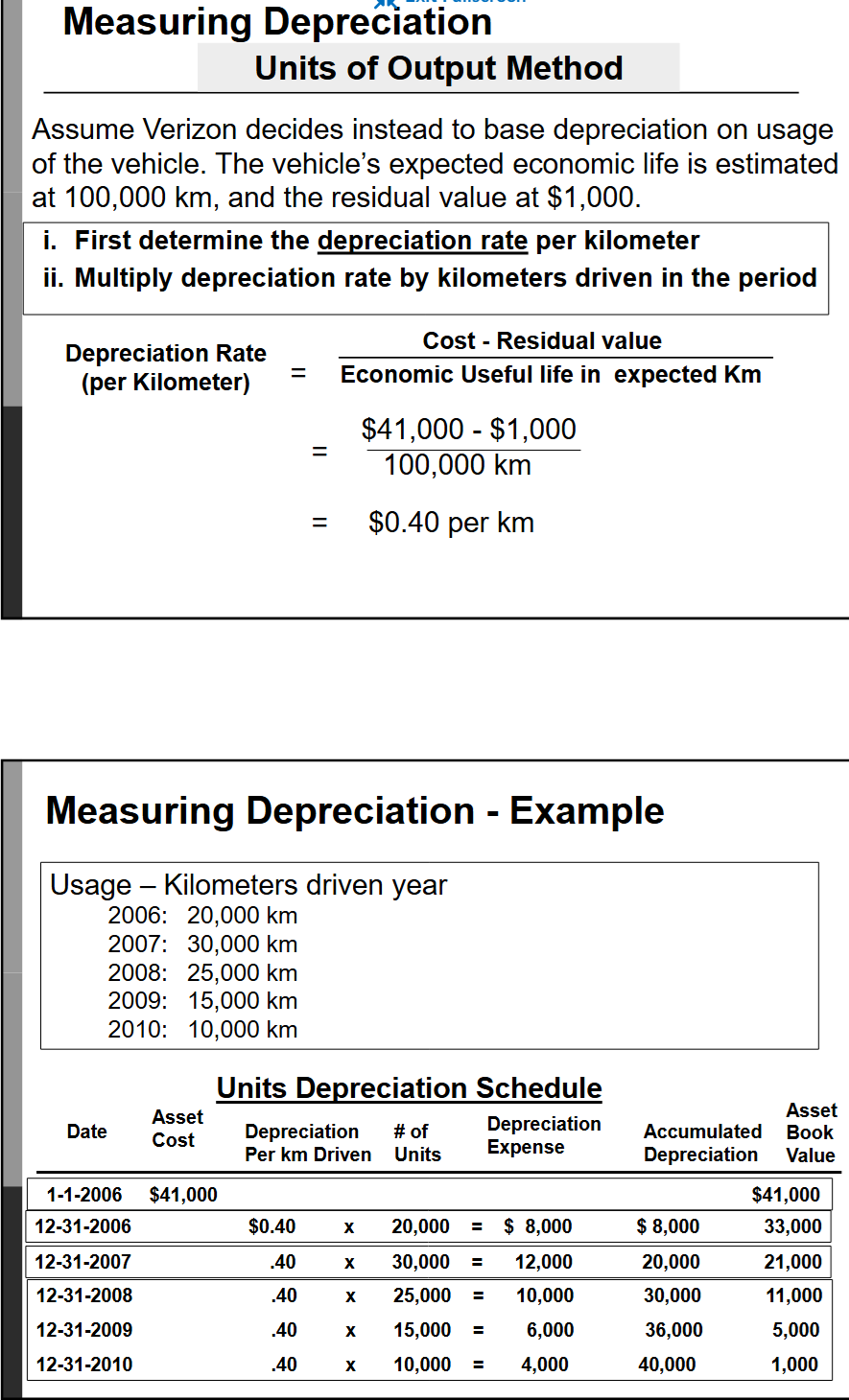
Measuring depreciation - units of output method
Depreciation rate (per km) = cost - residual value / economic useful life in expected km
Depreciating the cost, evenly
Quantity usage = how much the vehicle was driven → more quantity usage = more depreciation
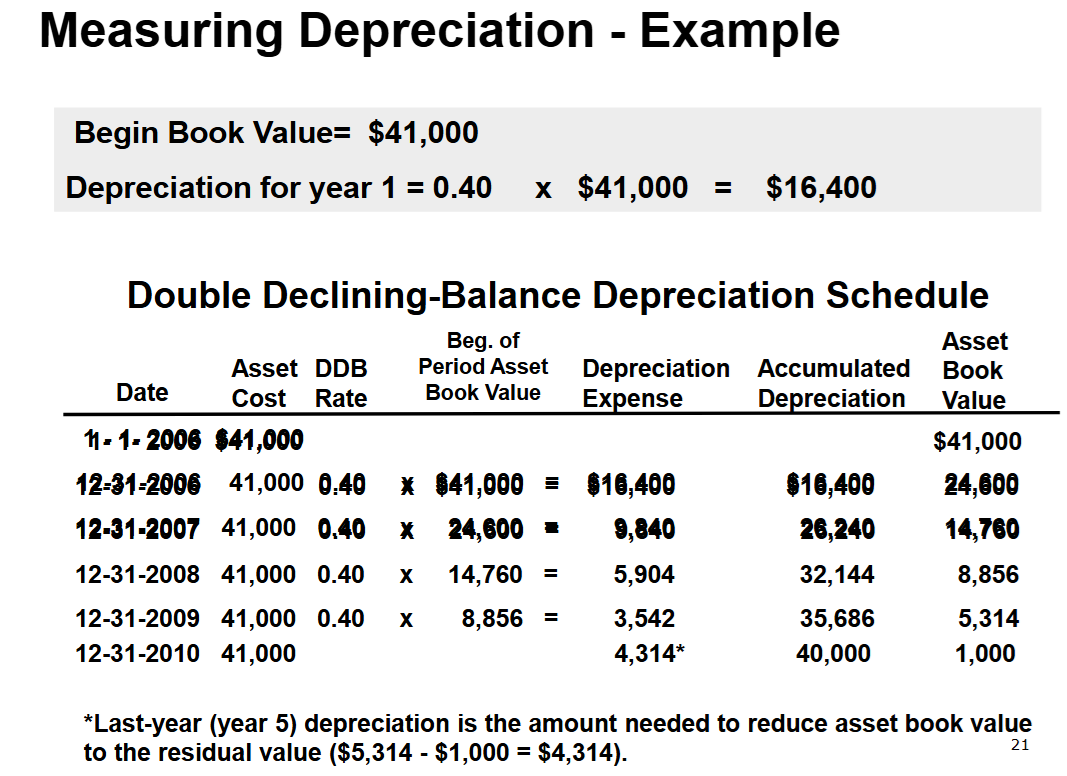
Measuring depreciation - acceleration depreciation method
Double declining-balance (DDB) method
A method that writes off a relatively larger amount of the asset’s cost nearer the start of its useful life than the straight-line method
Computes annual depreciation by multiplying the asset’s book value by a constant percentage, which is twice the straight-line depreciation rate hence the “double”.
Differs from other methods in two ways:
The asset’s residual value is ignored initially. In the first year depreciation is computed on the asset’s full cost
Depreciation expense in the final year is whatever amount is needed to reduce the asset’s book value to its residual value
DDB depreciation rate per year = 1 / useful life, in years X 2
Depreciation expense = beginning book value of asset X DDB rate
Comparing depreciation methods
1) The straight line method best meets the matching principle for a plant asset that generates revenue evenly over time
97% of companies use SL
More predictable
2) The units method best fits those assets that wear out because of physical use rather than obsolescence
5% of companies use units
3) The accelerated method (DDB) applies best to those assets that generate greater revenue earlier in their useful lives
11% of companies use an accelerated method
Using fully depreciated assets
A fully depreciated asset is:
An asset that has reached the end of its estimated useful life
An asset on which no more depreciation is recorded
The asset and its depreciation account remain in the ledger with no additional depreciation entries
An asset can be used after it is fully depreciated; foresight is not perfect
Depreciation changes
Depreciation may change because of:
Assumptions change
Method change
Apply new assumptions or method prospectively
Use going forward without changing prior years’ financial statements
Companies must disclose the effects of the change and justify why the new method is preferable
Impairment tests for tangible
If events and circumstances indicate that impairment is more likely than not, an interim impairment test must be conducted:
Uninsured or partially insured disasters
Adverse change in business climate
Unanticipated competition
Impairment tests for tangible assets
Changes in the fair value (aka market value) of long-lived assets
The market value of assets may change over time - it may increase or decrease
U.S. GAAP does not permit firms to increase carrying values of tangible and intangible long-lived assets when the fair values of their assets increase. IFRS allows fair values to be increased under certain circumstances.
Impairment accounting tangible and finite-life intangible assets
Type of operational asset: to be held and used
Tangible assets
Finite-life intangible assets
Periodic depreciation/amortization:
Yes - amortized or depreciated over expected useful life
When to test for impairment:
When events or circumstances indicate book value may not be recoverable
Impairment test:
Step 1
i. An impairment loss is required only when book value is not recoverable
ii. When is it unrecoverable?
When undiscounted sum of estimated future cash flows less than book value
Step 2
The amount of the impairment loss is the excess of book value over fair value
Impairment accounting tangible and finite-life intangible assets
When to conduct an impairment test: book value vs. fair value
Dis something happen to suggest the asset
Fair value < book value
No: stop, do nothing
Yes: Go to step 1
Conducting an impairment test - step 1: book value vs. recoverable amount
Compare asset book value & recoverable amount
Recoverable amount < book value
No: stop, do nothing
Yes: Go to step 2
Conducting an impairment loss - step 2: book value vs. fair value
Compare asset book value & fair value
Fair value - book value < 0
No: stop, do nothing
Yes:
i. Calculate impairment loss: fair value - book value = $ loss
ii. Dr. Operating expense $ loss, Cr. Asset $ loss
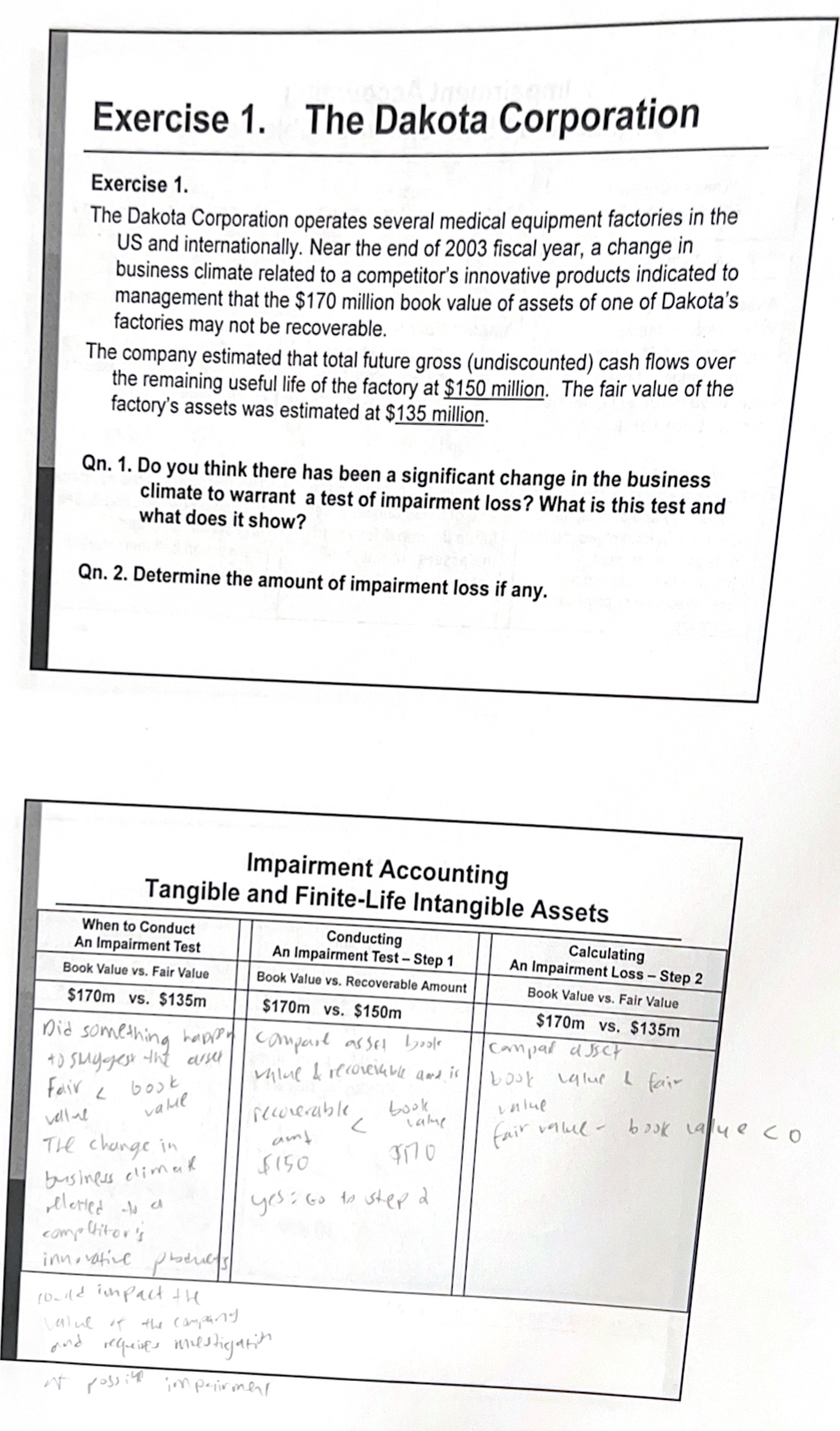
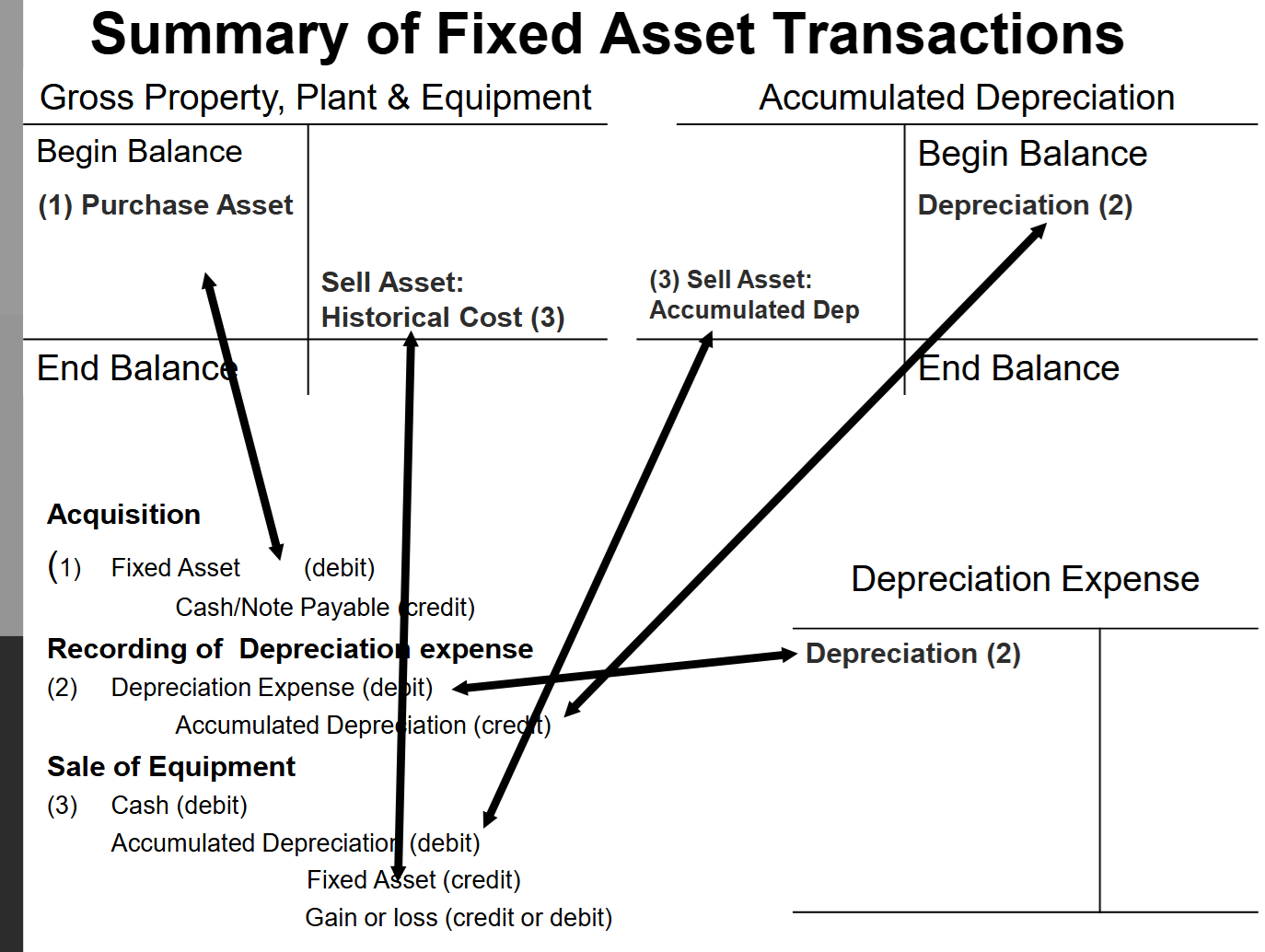
Disposal of fixed assets
A gain is recorded when an asset is sold for a price greater than the asset’s book value
Gains increase net income (credit, similar to revenue)
A loss is recorded when the sale price is less than book value
Losses decrease net income (debit, similar to expense)
Any cash proceeds from sale are reported in investing section of cash flow statement
Sales price (cash proceeds)
- book value of asset sold
= Gain (loss)
Accounting for intangible assets
Intangible assets are long-lived assets that are contractual, not physical in nature
Patents
Copyrights
Trademarks
Franchises and licenses
Computer software costs incurred after technological feasibility
Goodwill (the excess cost of an acquired company over the sum of the market value of its net assets)
Internally-generated research and development costs, advertising and employee training are NOT assets as defined by FASB. They must be expensed immediately.
Amortization methods for finite life - intangible assets
Residual value is presumed to be zero unless
Another entity which has committed to purchase it for a certain price at a future date
A market for intangible exists and is expected to exist at end of asset’s useful life to current owner
Amortization expense = cost / economic life
Accounting for goodwill
Before acquisition - two separate companies
Diversified company
Target company
After acquisition - one company with a subsidiary
Diversified company and target company
Goodwill formula
Goodwill = price paid for acquired company - fair value of net assets of acquired company
Amortization of indefinite life intangibles
Goodwill:
Not amortized
Subject to impairment test. Any goodwill impairment is recognized as an expense.
Other indefinite life intangible assets:
Not amortized
Subject to impairment test at least.
Impairment test of goodwill
Another two step process
Reporting unit:
The acquired company (operates as a subsidiary)
Carrying value (of the acquired company)
Fair value (market value) of the acquired company at the beginning of the current period
Current value (of the acquired company)
Fair value (market value) of the acquired company at the end of the period
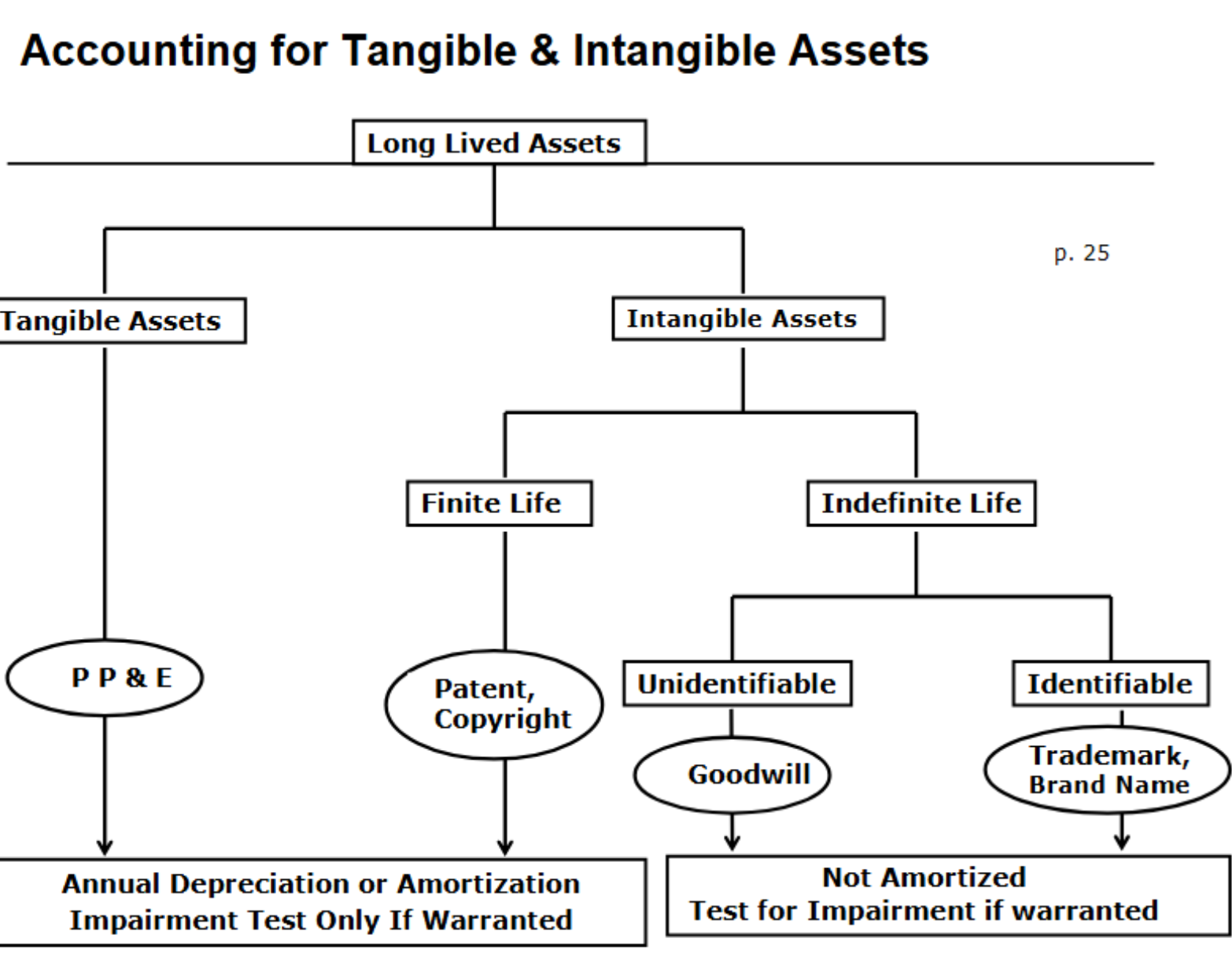
Classifying assets
Tangible asset - finite life
Physical assets
Identifiable intangible asset - finite life
Patents
Franchises and licenses
Identifiable intangible asset - infinite life
Copyrights
Trademarks
Computer software costs incurred after technological feasibility
Unidentifiable intangible asset - infinite life
Goodwill
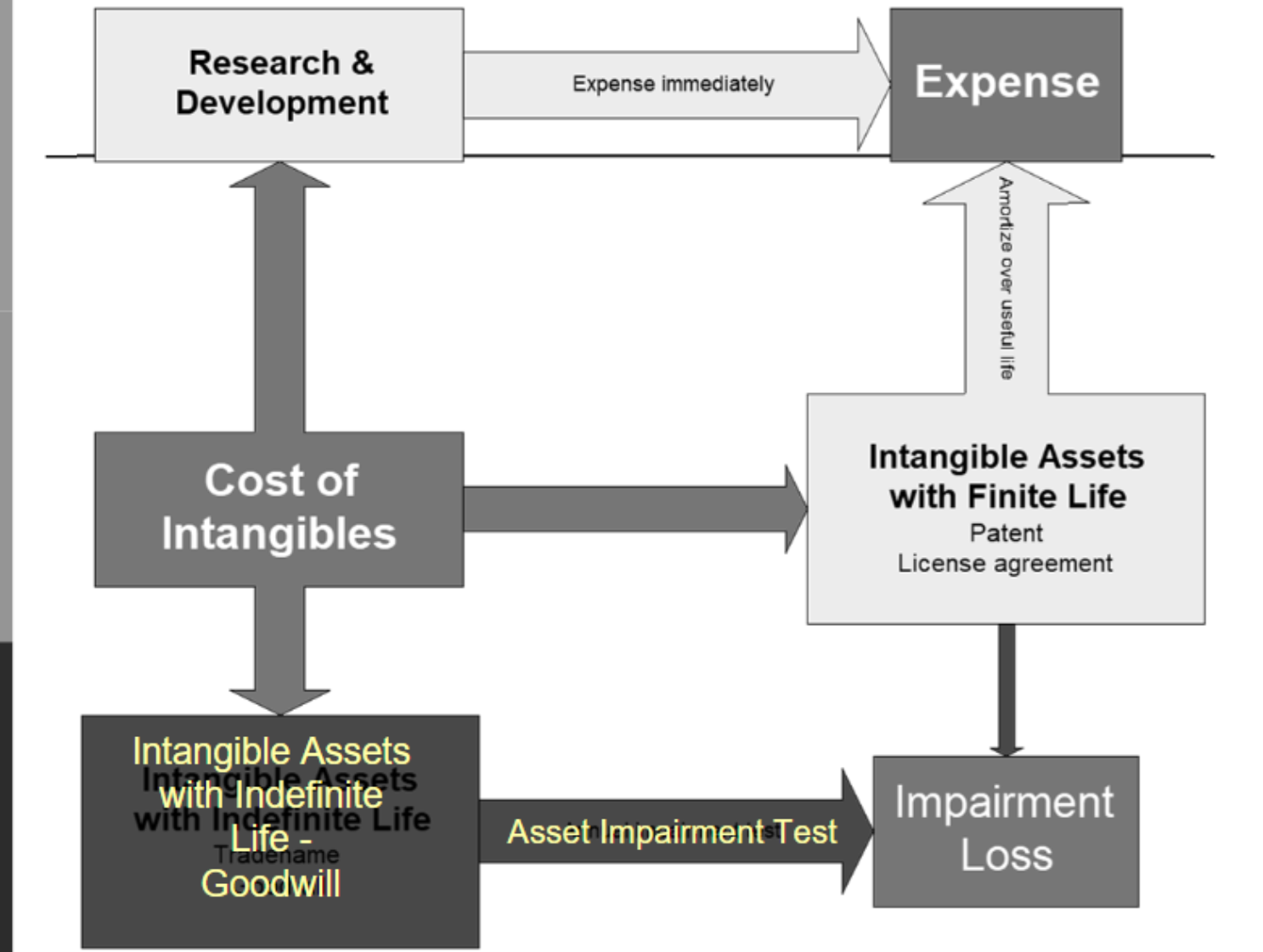
Goodwill impairment - illustration
In 2001, the Upjane Corporation acquired Pharmacopia Corporation for $500
million. Upjane recorded $100 million in goodwill related to this acquisition
because the fair value of the net assets of Pharmacopia was $400 million. After
the acquisition, Pharmacopia continued to operate as a separate company and
was considered a reporting unit for accounting purposes.
Upjane performs a goodwill impairment test at the end of every fiscal year. The
carrying value (i.e., book value) of the entire Pharmacopia unit was $480 at end
of 2002. This amount was unchanged from the estimated market value of the
unit at the end of 2001. The carrying value (i.e., book value) of goodwill
associated with the Pharmacopia unit at the beginning of 2003 was $100m.
For the purposes of the goodwill impairment test, the fair value (i.e., market
value) of the entire Pharmacopia’s unit was estimated at $350 million.
